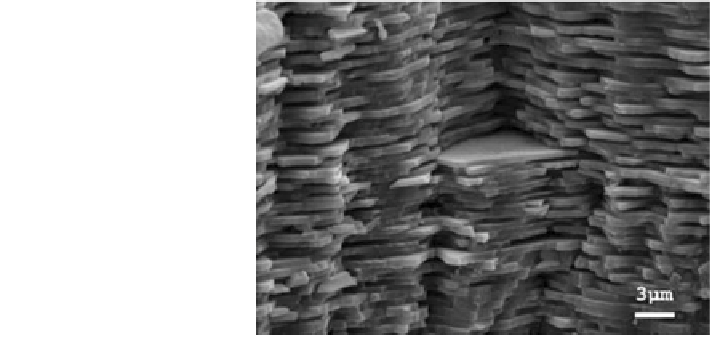Environmental Engineering Reference
In-Depth Information
Fig. 3.2 Electron
microscopy image showing
the characteristic
arrangement of layers of
aragonite ''bricks'' in nacre.
Image source Wikimedia
commons, Fabian
Heinemann, public domain
tablets (95 %wt) and protein layers (5 %wt) into a brick and mortar fashion
(Fig.
3.2
) provides a bending strength one order of magnitude higher than pure
aragonite and a 3,000 times higher work of fracture (Meyers et al.
2008
).
At high tensile stress, the crystal tablets will slide on one another and the
organic layer will suffer viscoplastic deformation, allowing nacre to withstand
stretch and dissipate energy (Barthelat
2007
). Fabrication techniques such as
freeze casting, hot-press assisted slip casting, extrusion and roll compaction, layer-
by-layer self-assembly, and paper-making method have successfully yielded
materials that mimic the mechanical properties of nacre (Corni et al.
2012
).
Enamel. The hardest material in vertebrates is enamel, a specialized tissue
present in the outer layer of teeth. The microscopic arrangement of 5 lm rods of
hydroxyapatite (the biologically common form of calcium phosphate crystals) and a
high mineralization confer a hardness of 4 GPa to enamel (Meyers et al.
2008
). The
low toughness of enamel is balanced by the dentin that composes the inner layer of
teeth. It comprises 30 % vol. of collagen, the structural protein present in most
body tissues, and 25 % vol. of water, along with hydroxyapatite crystals, which
assemble themselves around the collagen tubules to form a porous, though tough
and light, material (Corni et al.
2012
). The development of hard and resistant teeth
by animals allowed them to explore a wider range of food sources.
Bone. The mimicking of the porous and branched structure of bone is ubiquitous
in the work of some renowned architects, originating structures that are lightweight
and tough [e.g., Casa Batlló and La Sagrada Família (Barcelona, Spain) by Antoni
Gaudí or Gare do Oriente (Lisbon, Portugal) by Santiago Calatrava]. Bone has
evolved to provide efficient structural support to vertebrates and protect their vital
organs and is thus an interesting material to emulate for construction and safety
applications. It is composed of hydroxyapatite mineralized collagen fibrils arranged
across seven hierarchical levels into lamellar-structured osteons in a porous matrix.
The strength of bone is controlled by its constituents at two levels: an intrinsic
toughening based on plastic deformation of organic molecules at the submicron
scale and an extrinsic toughening based on crack-tip shielding of osteons at macro

Search WWH ::

Custom Search